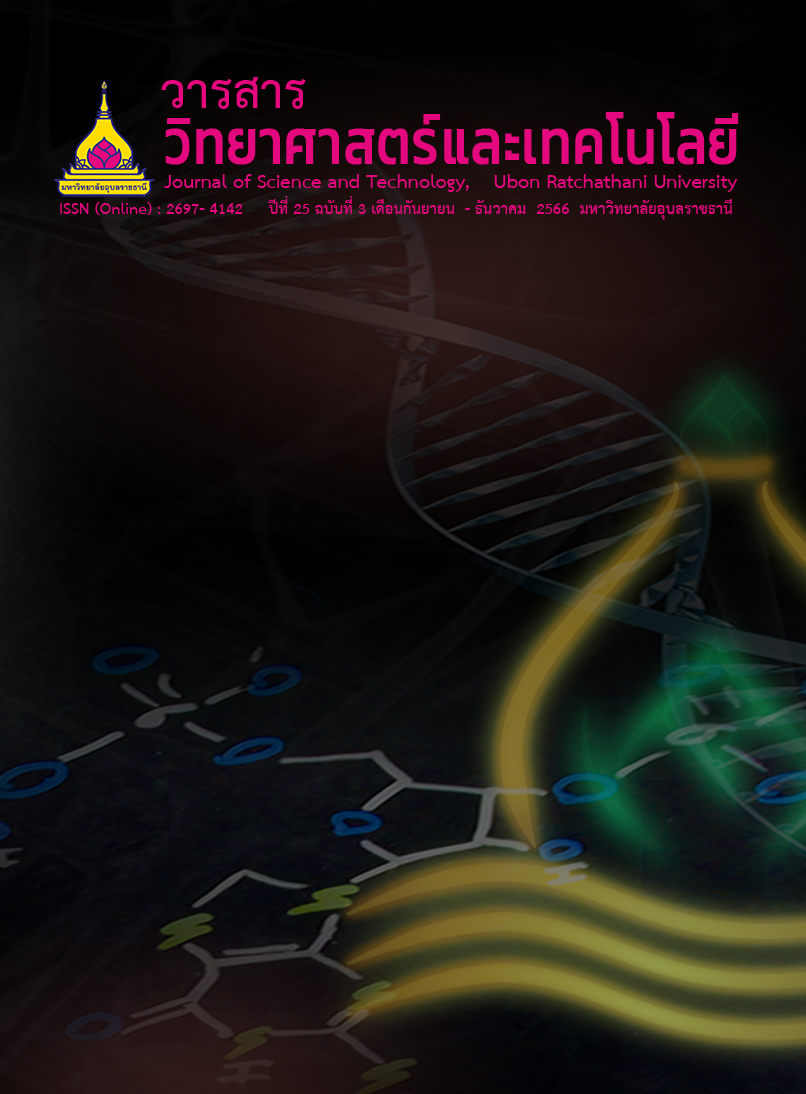ฤทธิ์ต้านแบคทีเรียของสารสกัดจากผลมะขามป้อม (Phyllanthus emblica L.) และการประยุกต์ใช้ในการลดจำนวนแบคทีเรียบนเนื้อหมู
Main Article Content
บทคัดย่อ
มะขามป้อม (Phyllanthus emblica L.) เป็นพืชสมุนไพรที่มีการนำมาใช้ประโยชน์อย่างแพร่หลาย และมีการรายงานทางวิทยาศาสตร์ว่ามีฤทธิ์ยับยั้งเชื้อแบคทีเรีย งานวิจัยนี้มีวัตถุประสงค์เพื่อทดสอบฤทธิ์ต้านแบคทีเรียของสารสกัดจากผลมะขามป้อมด้วย ตัวทำละลายต่าง ๆ ในระดับห้องปฏิบัติการ และการประยุกต์ใช้สารสกัดดังกล่าวด้วยเอทานอลในการลดจำนวนแบคทีเรียบนเนื้อหมู ในงานวิจัยนี้ได้สกัดผลมะขามป้อมด้วยตัวทำละลายต่างชนิดกัน ได้แก่ อะซิโตน เมทานอล เอทานอล และน้ำ การทดสอบฤทธิ์ต้านแบคทีเรียของสารสกัดดังกล่าวใช้วิธี agar disc diffusion และเลือกสารสกัดที่จะนำไปประยุกต์ใช้กับเนื้อหมู (สารสกัดด้วยเอทานอล) มาหาค่าความเข้มข้นที่น้อยที่สุดในการยับยั้ง (MICs) และค่าความเข้มข้นที่น้อยที่สุดในการฆ่าแบคทีเรีย (MBCs) กับแบคทีเรียแกรมบวกจำนวน 5 ชนิด และแบคทีเรียแกรมลบจำนวน 7 ชนิด ด้วยวิธี broth microdilution ผลการทดลองพบว่าสารสกัดจากผลมะขามป้อมที่สกัดด้วยตัวทำละลายต่าง ๆ มีฤทธิ์ยับยั้งเชื้อแบคทีเรียแกรมบวก และสารสกัดมะขามป้อมที่สกัดด้วยเอทานอลมีค่า MICs และค่า MBCs ต่อแบคทีเรียทดสอบอยู่ระหว่าง 2.5-10 มิลลิกรัมต่อมิลลิลิตร และ 10-40 มิลลิกรัมต่อมิลลิลิตร ตามลำดับ การประยุกต์ใช้สารสกัดด้วยเอทานอลกับเนื้อหมูแสดงให้เห็นว่าสารสกัดที่ความเข้มข้น 8MIC (80 มิลลิกรัมต่อมิลลิลิตร) และ 16MIC (160 มิลลิกรัมต่อมิลลิลิตร) สามารถลดจำนวนเซลล์แบคทีเรียบนเนื้อหมูได้อย่างมีนัยสำคัญ งานวิจัยนี้ได้แสดงให้เห็นว่าสารสกัดจากผลมะขามป้อมมีฤทธิ์ฆ่าเชื้อแบคทีเรีย และมีศักยภาพในการพัฒนาเป็นสารออกฤทธิ์ควบคุมการเจริญของเชื้อแบคทีเรีย
Article Details

อนุญาตภายใต้เงื่อนไข Creative Commons Attribution-NonCommercial-NoDerivatives 4.0 International License.
บทความที่ได้รับการตีพิมพ์เป็นลิขสิทธิ์ของ วารสารวิทยาศาสตร์และเทคโนโลยี มหาวิทยาลัยอุบลราชธานี
ข้อความที่ปรากฏในบทความแต่ละเรื่องในวารสารวิชาการเล่มนี้เป็นความคิดเห็นส่วนตัวของผู้เขียนแต่ละท่านไม่เกี่ยวข้องกับมหาวิทยาลัยอุบลราชธานี และคณาจารย์ท่านอื่นๆในมหาวิทยาลัยฯ แต่อย่างใด ความรับผิดชอบองค์ประกอบทั้งหมดของบทความแต่ละเรื่องเป็นของผู้เขียนแต่ละท่าน หากมีความผิดพลาดใดๆ ผู้เขียนแต่ละท่านจะรับผิดชอบบทความของตนเองแต่ผู้เดียว
เอกสารอ้างอิง
Dwivedi, S. and et al. 2017. A review on food preservation: Methods, harmful effects and better alternatives. Asian Journal of Pharmacy and Pharmacology. 3(6): 193-199.
Amit, S.K. and et al. 2017. A review on mechanisms and commercial aspects of food preservation and processing. Agriculture & Food Security. 6: 51.
Campelo, M.C.S., Medeiros, J.M.S. and Silva, J.B.A. 2019. Natural products in food preservation. International Food Research Journal. 26(1): 41-46.
Phumkhachorn, P., Thothom, P. and Rattana chaikunsopon, P. 2022. Antimicrobial activity and mechanism of thymol against Listeria monocytogenes. Journal of Science and Technology, Ubon Ratchathani University. 24(2): 40-47. (in Thai)
Ahmad, B. and et al. 2021. Phyllanthus emblica: A comprehensive review of its therapeutic benefits. South African Journal of Botany. 138: 278-310.
Saini, R. and et al. 2022. Traditional uses, bioactive composition, pharmacology, and toxicology of Phyllanthus emblica fruits: A comprehensive review. Journal of Ethnopharmacology. 282: 114570.
Visutthi, M. 2016. Anti-bacterial and anti-quorum sensing properties of selected medicinal plants from Nakhon Ratchasima province, Thailand. Progress in Applied Science and Technology. 6(1): 1-13.
Visutthi, M. and Earm-aot, A. 2018. In situ anti-Staphylococcus aureus activities of ethanolic leaf extract of Rhodomyrtus tomentosa (Aiton) Hassk. in raw chilled pork. Progress in Applied Science and Technology. 8(2): 169-178. (in Thai)
Visutthi, M. 2016. Anti-staphylococcal screening of selected Thai medicinal plants from Nakhon Ratchasima province. Suranaree Journal of Science and Technology. 23: 109-114.
Visutthi, M. 2017. Antagonistic effect of staphylococci of extracts from some local plants in Nakorn Ratchasima province. KKU Science Journal. 45(4): 805-816. (in Thai)
Davis, J.L. 2018. Chapter 2 - Pharmacologic Principles. In: Reed, S.M., Bayly, W.M., Sellon, D.C. (eds.) Equine Internal Medicine. 4th edition. Philadelphia: W.B. Saunders.
Liu, X. and et al. 2008. Antioxidant activity of methanolic extract of emblica fruit (Phyllanthus emblica L.) from six regions in China. Journal of Food Composition and Analysis. 21(3): 219-228.
Khan, A. and et al. 2018. Comparative therapeutic efficacy of Phyllanthus emblica (Amla) fruit extract and procaine penicillin in the treatment of subclinical mastitis in dairy buffaloes. Microbial Pathogenesis. 115: 8-11.
Van Doan, H. and et al. 2022. Impacts of Amla (Phyllanthus emblica) fruit extract on growth, skin mucosal and serum immunities, and disease resistance of Nile tilapia (Oreochromis niloticus) raised under biofloc system. Aquaculture Reports. 22: 100953.


